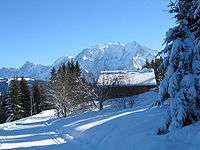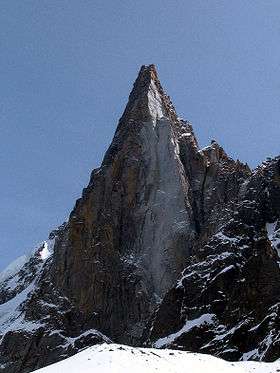Saint Gervais-les-Bains
| Saint-Gervais-les-Bains | ||
|---|---|---|
|
A general view of Saint-Gervais-les-Bains | ||
| ||
 Saint-Gervais-les-Bains | ||
|
Location within Auvergne-Rhône-Alpes region  Saint-Gervais-les-Bains | ||
| Coordinates: 45°53′36″N 6°42′50″E / 45.8933°N 6.7139°ECoordinates: 45°53′36″N 6°42′50″E / 45.8933°N 6.7139°E | ||
| Country | France | |
| Region | Auvergne-Rhône-Alpes | |
| Department | Haute-Savoie | |
| Arrondissement | Bonneville | |
| Canton | Saint-Gervais-les-Bains | |
| Intercommunality | Pays du Mont-Blanc | |
| Government | ||
| • Mayor | Jean-Marc Peillex | |
| Area1 | 63.63 km2 (24.57 sq mi) | |
| Population (2006)2 | 5,742 | |
| • Density | 90/km2 (230/sq mi) | |
| Time zone | CET (UTC+1) | |
| • Summer (DST) | CEST (UTC+2) | |
| INSEE/Postal code | 74236 / 74170 | |
| Elevation | 571–4,810 m (1,873–15,781 ft) | |
|
1 French Land Register data, which excludes lakes, ponds, glaciers > 1 km² (0.386 sq mi or 247 acres) and river estuaries. 2 Population without double counting: residents of multiple communes (e.g., students and military personnel) only counted once. | ||
Saint-Gervais-les-Bains is a commune in the Haute-Savoie department in the Auvergne-Rhône-Alpes region in south-eastern France. The village is best known for tourism, and has been a popular holiday destination because of its beauty and location since the early 1900s. It has 450 km of ski pistes, reputed to be the third largest domain exclusively in France, and is one of the least busy ski areas of its size. In 1892, two hundred people were killed when a water pocket in a glacier above the town suddenly burst open, causing destructive flooding.
Geography
The wider administrative area of the commune of St Gervais encompasses several separate villages, as well as the summit of Mont Blanc. Consequently, the commune has a very large variation in altitudes, ranging from the village of Le Fayet at 570m up to the summit of Mont Blanc at 4810m, with the main town of St Gervais at just under 900m in altitude.
Tourism

St Gervais les Bains (also referred to as St Gervais or St Gervais Mont Blanc) is not a recently purpose built resort, and so has a significant year round population, rather than just seasonal and is full of historical buildings giving it the traditional charm much sought after in the Alps.
In winter, the main draw is of course snow sports, and the resort has a multi-national client base. It is increasing in popularity among British holiday-makers, in part due to the fact that as yet it is fairly empty of Britons and large tour operators, and retains the character of a French ski village. The summer sees tourists arrive from around the world to explore the numerous fair weather alpine activities available such as Mountain Biking, Climbing, Hiking, Paragliding, Rafting, etc. as well as making use of the all year thermal spa 'Les Thermes' which sits within the beautiful 'Parc Thermal' in the lower village of Le Fayet.
Recent holiday companies have expanded in the area following increased demand, although the majority of chalet holiday companies offering accommodation to guests are independent "owner-run" chalets and therefore the town and the ski domain manage to avoid the heavy congestion of some of this resorts more famous neighbours.
Transportation
The main railway station for Saint-Gervais is the Gare de Saint-Gervais-les-Bains-Le Fayet. The fabulous and historic Mont Blanc Tramway departs from Le Fayet station and reaches the Nid d'Aigle station at the Bionnassay glacier at an altitude of 2372 m (7800 ft). The Saint-Gervais–Vallorcine railway departs from Le Fayet station and takes you to Chamonix and across the Swiss border to Martigny. Numerous other destinations throughout France (including direct trains to Paris) can be accessed from the main SNCF station at Le Fayet, and the main resort is just a 10-minute descent to the nearby A40 Peage motorway to Geneva, Lyon, Paris and connecting to the rest of the French motorway network.
People
The French ski jumper Marie Hoyau is a native of St. Gervais.
The Catastrophe of Saint Gervais
On 11 July 1892, a hidden lake burst out of the Tête Rousse Glacier on the slopes of the mountains above the town. It flooded the valley, razed the hamlet of Bionnay, and reached St Gervais and Le Fayet, killing 200 people in its path. In 2010 the rediscovery of a large water pocket deep within the glacier caused alarm, and to this day has the potential to threatened another outburst flood. Melt-water pumping, formal evacuation plans and installation of a siren alarm system in 2013 have all been implemented to reduce the threat to life.[1][2][3][4]
See also
References
- ↑ Vallot, Joseph (20 August 1892). "La Catastrophe de Saint-Gervais (12-13 Juillet 1892)". La Nature (1003). Retrieved 28 February 2016.
- ↑ Peillex, Jean-Marc (December 2013). "Projections: Le journal d'informations municipales des Saint-Gervolains" (PDF). www.saintgervais.com. Retrieved 24 February 2016.
- ↑ Vincent, C. (2010). "Origin of the Outburst flood from the Glacier de Tete Rousse in 1892" (PDF). Journal of Glaciology. Retrieved 19 February 2016.
- ↑ Clark, Tim (4 August 2010). "Flood risk in French Alps after water pocket discovered under Mont Blanc glacier". Daily Mail Online. Retrieved 23 February 2016.
External links
| Wikimedia Commons has media related to Saint-Gervais-les-Bains. |
- Tourism Office website (in English)
- Official site of the commune (in French)
- INSEE
- Saint-Gervais Village at Google Cultural Institute
| Wikivoyage has a travel guide for Saint-Gervais-les-Bains. |

.svg.png)


